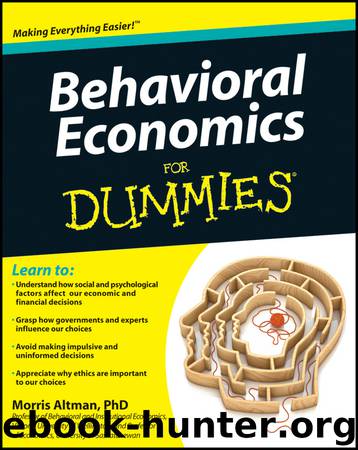Behavioral Economics For Dummies by Morris Altman

Author:Morris Altman
Language: eng
Format: epub
Publisher: Wiley
Published: 2012-01-18T16:00:00+00:00
Chapter 9
Why Gender, Children, and Age Matter for Economic Analysis
In This Chapter
Understanding how gender affects decision making
Recognizing the role that children’s preferences play in a household’s decisions
Exploring the importance of aging to the choices people make
Women and men have different preferences on a variety of issues, and those preferences often result in different choices. But gender isn’t the only thing that affects preferences and choice — so do children and aging. Kids tend to have different preferences than adults do. And parents have different preferences than adults without kids do. Finally, some preferences change as people get older. You aren’t who you were in the past, nor are you today who you will become in the future. Preferences evolve over time, and economists need to incorporate this evolution into our simplifying assumptions of choice behavior.
In this chapter, I focus on how gender, children, and age affect preferences and choice.
How Gender Affects Choice
Conventional economics wisdom says that men and women have the same preferences. In other words, gender makes no difference to choice behavior. Conventional economics also assumes that men’s choices are excellent representations of the preferred choices of women. After all, if men and women have the same preferences, a man can stand in for a woman without any problem.
As you probably guessed, behavioral economics sees things a bit differently. Behavioral economics recognizes that women and men have different preferences on a variety of important issues. Recognizing these differences when modeling various economic problems allows us to better explain how events unfold and better inform public policy.
A good example of these differences relates to family planning, where women tend to prefer fewer kids than men do, regardless of economic incentives. Women also tend to care more about the well-being of children than men do. In this case, the gender of the person making the choices has a big impact on social and economic outcomes.
Not tonight, honey: Conventional choice theory
Conventional economics models work, up to a point, when gender is of no consequence. Men and women do have certain similarities in preferences at a more general level. For example, both men and women are sensitive to relative changes in price and income. But men are much more sensitive to the price of shaving cream than to the price of tampons. Ignoring gender has its place when and where gender truly doesn’t matter.
But when and where gender matters is an empirical question. We can’t simply assume that preferences are the same for men and women. If we do make this assumption, we move from a simplifying assumption to a simplistic and unrealistic assumption — one that misleads.
Demand for commodities when tastes are gender neutral
In conventional economics, the changing structure of demand is often assumed to be a product of a representative (average) individual, who has no gender and responds to changes in relative prices and changes in income. This sexless individual may drive the demand in different ways and even for new goods and services. But this
Download
Behavioral Economics For Dummies by Morris Altman.epub
This site does not store any files on its server. We only index and link to content provided by other sites. Please contact the content providers to delete copyright contents if any and email us, we'll remove relevant links or contents immediately.
International Integration of the Brazilian Economy by Elias C. Grivoyannis(98676)
The Radium Girls by Kate Moore(11970)
Turbulence by E. J. Noyes(7977)
Nudge - Improving Decisions about Health, Wealth, and Happiness by Thaler Sunstein(7655)
The Black Swan by Nassim Nicholas Taleb(7054)
Rich Dad Poor Dad by Robert T. Kiyosaki(6507)
Pioneering Portfolio Management by David F. Swensen(6253)
Man-made Catastrophes and Risk Information Concealment by Dmitry Chernov & Didier Sornette(5952)
Zero to One by Peter Thiel(5730)
Secrecy World by Jake Bernstein(4698)
Millionaire: The Philanderer, Gambler, and Duelist Who Invented Modern Finance by Janet Gleeson(4418)
The Age of Surveillance Capitalism by Shoshana Zuboff(4243)
Skin in the Game by Nassim Nicholas Taleb(4200)
Bullshit Jobs by David Graeber(4137)
The Money Culture by Michael Lewis(4130)
Skin in the Game: Hidden Asymmetries in Daily Life by Nassim Nicholas Taleb(3960)
The Dhandho Investor by Mohnish Pabrai(3721)
The Wisdom of Finance by Mihir Desai(3693)
Blockchain Basics by Daniel Drescher(3538)
